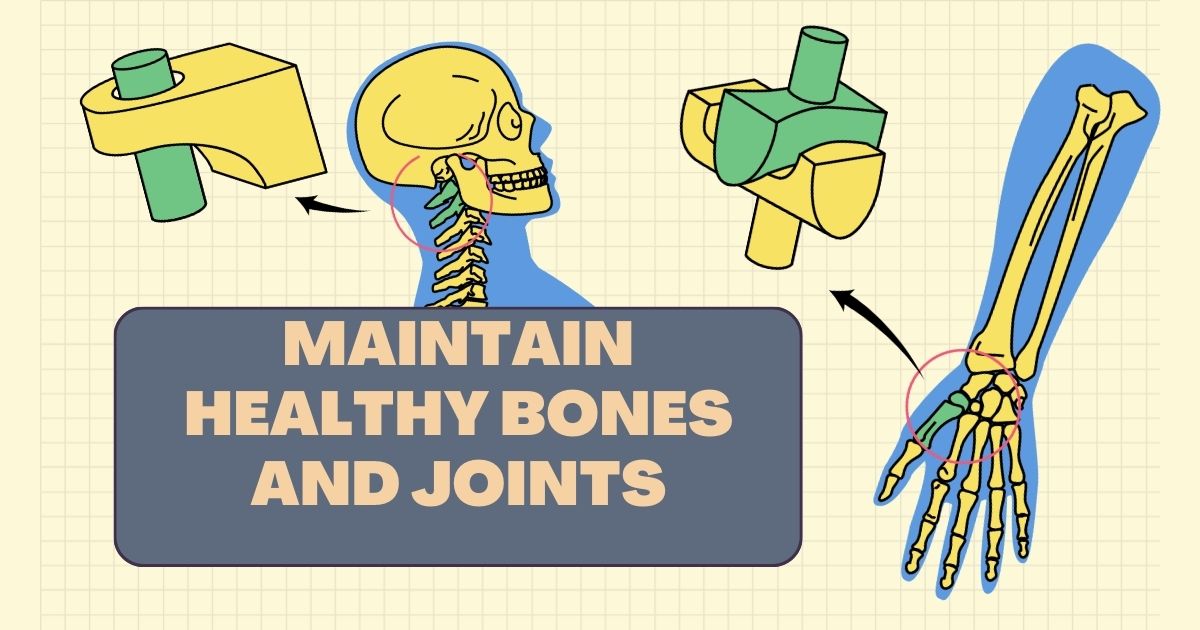Strong bones and flexible joints are the foundation of a healthy body. They support movement, balance, and overall quality of life. As we age, bones naturally lose density and joints may stiffen, increasing the risk of osteoporosis, arthritis, and fractures. However, with the right nutrition, exercise, and lifestyle habits, it is possible to maintain bone and joint health throughout life. This article explores practical strategies on how to maintain healthy bones and joints for long-term strength and mobility.
Importance of Healthy Bones and Joints
Bones provide structure, protect organs, and store calcium, while joints enable smooth, pain-free movement. Weak bones increase fracture risk, while stiff or inflamed joints reduce flexibility and cause discomfort. Healthy bones and joints not only ensure mobility but also support independence and active living, especially in older adults.
Nutrients Essential for Bone and Joint Health
Calcium
Calcium is the building block of bones. Consuming adequate calcium throughout life helps maintain bone density and strength. Dairy products, leafy greens, almonds, and fortified plant-based milk are excellent sources.
Vitamin D
Vitamin D helps the body absorb calcium effectively. Sunlight exposure, fatty fish, egg yolks, and fortified foods provide this essential nutrient. For those with limited sun exposure, supplements may be necessary.
Protein
Protein supports muscle health, which in turn stabilizes bones and joints. Include lean meats, beans, lentils, nuts, and tofu in your daily diet.
Omega-3 Fatty Acids
Omega-3s have anti-inflammatory properties that benefit joint health. Sources include salmon, chia seeds, flaxseeds, and walnuts.
Magnesium and Vitamin K
Magnesium aids calcium absorption, while Vitamin K supports bone mineralization. Foods like whole grains, spinach, and broccoli are good sources.
Best Foods for Strong Bones and Joints
-
Dairy products: Milk, cheese, yogurt
-
Leafy greens: Kale, spinach, collard greens
-
Nuts and seeds: Almonds, chia seeds, flaxseeds
-
Fish: Salmon, sardines, mackerel
-
Fruits: Oranges, berries, and prunes
-
Whole grains: Brown rice, quinoa, oats
Incorporating these foods regularly ensures the body gets essential nutrients for optimal bone and joint strength.
Exercise for Bone and Joint Health
Weight-Bearing Exercises
Walking, jogging, hiking, and dancing strengthen bones by putting stress on them, which encourages density.
Strength Training
Lifting weights, resistance bands, or bodyweight exercises like squats and push-ups improve both muscle and bone strength.
Flexibility and Balance Exercises
Yoga, Pilates, and tai chi help maintain joint flexibility, improve posture, and reduce the risk of falls.
Low-Impact Activities
Swimming and cycling are gentle on the joints while promoting cardiovascular fitness and mobility.
Lifestyle Habits That Support Bone and Joint Health
Maintain a Healthy Weight
Excess weight puts pressure on joints, particularly the knees and hips. Managing weight through diet and exercise reduces wear and tear.
Quit Smoking and Limit Alcohol
Smoking weakens bones, while excessive alcohol interferes with calcium absorption. Reducing these habits significantly improves bone and joint health.
Stay Hydrated
Cartilage, which cushions the joints, is largely made of water. Drinking enough fluids keeps joints lubricated and reduces stiffness.
Posture and Ergonomics
Sitting or standing with proper posture reduces strain on bones and joints. Ergonomic chairs and workstations help maintain spinal alignment.
Preventing Bone and Joint Disorders
-
Osteoporosis prevention: Ensure adequate calcium and vitamin D intake, engage in weight-bearing exercises, and avoid smoking.
-
Arthritis management: Maintain a healthy weight, perform joint-friendly exercises, and eat anti-inflammatory foods.
-
Injury prevention: Warm up before workouts, use supportive footwear, and avoid sudden high-impact movements.
When to See a Doctor
Seek medical advice if you experience:
-
Persistent joint pain or stiffness
-
Swelling or redness around joints
-
Frequent fractures or bone injuries
-
Noticeable loss of height (a sign of bone density loss)
Early diagnosis and treatment can help prevent long-term complications.
Also Read : How a Digital Detox Improves Your Health
FAQs
Q1. At what age should I start focusing on bone and joint health?
Bone and joint health should be prioritized from childhood, but it becomes especially important after age 30 when bone density naturally declines.
Q2. How much calcium do adults need daily?
Most adults need about 1,000–1,200 mg of calcium daily, depending on age and gender.
Q3. Can supplements replace a healthy diet for bone health?
Supplements can help fill nutritional gaps but should not replace a balanced diet rich in whole foods.
Q4. Is walking enough to strengthen bones?
Walking is beneficial, but combining it with strength training and flexibility exercises provides greater bone and joint protection.
Q5. What foods should I avoid for bone and joint health?
Limit processed foods, excessive salt, sugary drinks, and alcohol, as they can weaken bones and increase inflammation.



